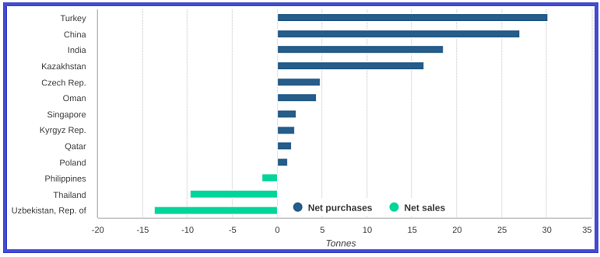A good friend of mine mentioned that CNBC’s website featured a positive article on gold on its front headlines page on May 27th. He was wondering if he should be worried when one of Wall Street’s public relations outlets turns bullish on the precious metals. It’s a valid question. However, one of the “experts” cited in the article was a strategist from Australia’s ANZ Bank, who attributed the price rise in the metals to “weakness in the US dollar” and “retreating U.S. Treasury yields.”
This was curious because that assertion is easily fact-checked. As it turns out, yes the US Dollar Index is 1.8% below where it was trading at the beginning of May, but it’s 4% above where it was at the beginning of 2024. Furthermore, the 10-year Treasury yield is considerably higher now than at the beginning of 2024 (4.55% now vs 3.87% then). In fact, the entire yield curve from the 2-year Treasury out to the 30-years Treasury has been trending higher since the beginning of the year.
Moreover, the Fed is not expected to lower the Fed funds rate until later this year, if at all. I thus would not be worried about the type of information that CNBC is publishing with respect to the precious metals market given that one of its so-called “expert” sources was predicating his attribution for the move higher in gold on factually incorrect information.
Rather, based on the available data, and recall that China only reports gold import data that flows through Hong Kong but not Beijing or Shanghai, China has been importing a massive amount of gold this year. Thus, eastern hemisphere gold buying, particularly from China, appears to be the force driving gold and silver prices higher currently.
It’s a given that the Chinese Central Bank is buying a lot of gold currently, and likely quite a bit more than it officially reports, in its effort to diversify its reserves out of U.S. dollars and into other forms of money. On top of that, the Chinese public is buying gold at a rate that is twice the amount of domestic gold mine production. According to the China Gold Association, consumers in China bought 308.9 tonnes (10.9 million ounces) of gold in Q1 2024. Chinese gold mines produced 139.1 tonnes of gold in Q1. 53.2 tonnes of that was a product of imported gold ore.
In addition, according to the World Gold Council – and we know it is unable to track all of the gold imported by China – Central Banks globally bought a record 290 tonnes of gold worth $24 billion in Q1 2024. But note that the ten Central Banks reporting an increase in gold reserves are based in the eastern hemisphere (chart and data from Metals Focus, World Gold Council and Refinitiv GFMS by way of the article linked above):
The graphic above is for Q1. In addition, in April India imported $3.11 billion worth of gold vs $1.01 billion in April 2023.
Given that a record amount of physical gold is being accumulated in the east right now, it’s pretty clear, at least to me, that the demand for physical gold is the biggest factor in driving the gold price higher.
The same analysis applies to silver. The Silver Institute is forecasting a 219 million-ounce supply deficit in 2024. However, with the sharp rise in the gold price, it appears that the Indians have shifted from buying gold to gorging on silver. In Q1 2024, India imported 3,730 tonnes of silver, which exceeded the amount imported for the full-year 2023. That rate is running about 50% higher than the all-time high of 9,450 in 2022. (source: Manisha Gupta, CNBCTV18 in India, news editor – commodities & currencies).
Silver imports into China do not get reported other than silver concentrate. But it is thought that China buys and uses quite a bit more silver than is produced domestically. The Chinese Government has been working on a massive nationwide solar energy installation program which uses most of the silver produced annually by the mining industry.
Data from the Shanghai Gold Exchange shows that silver withdrawals YTD through the end of April were up 16.6% YoY. The demand is coming from manufacturers and banks. Current premiums for silver on a daily basis have been running about 10% above the world spot price of silver, which reflects continued strong demand for silver in China.
The bottom line is that, while the western mainstream media and market “experts” appear to be clueless with regard to the factors driving gold and silver higher, an examination of the demand for both metals in the eastern hemisphere leads to the conclusion that an enormous amount of physical buying from Central Banks, industrial users and the general public is likely by far the biggest factor in both driving gold to all-time highs and also triggering a technical breakout of silver than are any macroeconomic factors in the U.S.
